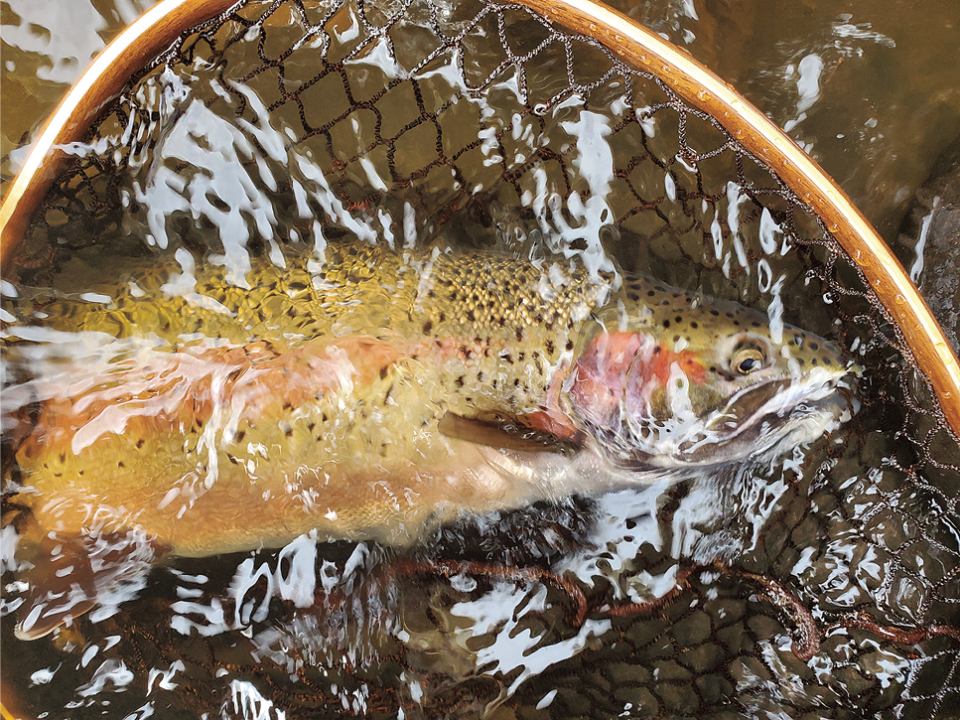It’s hard to recall just when it started. I remember Dad picked me up after morning kindergarten on a spring day and we went to a river on the edge of Duluth, where you could see big, black schools of smelt in shallow water at midday. They were so thick a little boy could walk along the shore and keep his feet dry while he caught 9-inch smelt with his hand. Wearing his hip boots, Dad even carried me out to the deeper water where I could sweep with a dip net and scoop up so many smelt that I couldn’t lift the net out of the water. So, Dad kept me in his arms and dragged the net to the bank.
Maybe that was the day it started. At any rate, since then I’ve lived near Lake Superior’s North Shore and fished its tributaries and the big lake more than anywhere else. The massive smelt runs disappeared around the time I graduated from college at the beginning of the 1980s. A non-native species, they were pushed out of their niche in Superior by the recovery native fish. A non-native that remained was the rainbow trout, which anglers started referring to as steelhead when I was an early teenager, because the big ones that ran up tributaries to spawn were much like their kin on the Pacific Coast. Some say Superior’s rainbows are indeed descended from western steelhead. But given the numbers of hatchery rainbow strains that have been stocked in the lake during my lifetime, I wonder if that is truly the case.
At any rate, the big rainbows are challenging to catch in tributaries large or small and have a draw on trout anglers that is unmatched by other trout and salmon species. I am among those anglers who have fallen for steelhead, a mystification that began at a young age. I’m not sure how young I was when I began fishing for them, but I remember Dad’s friends from Duluth’s far west end were usually at the Cable Hole on the Knife River. There, a cable prevented anglers from fishing within a closed refuge area at the waterfall that rainbows (as they were called then) had to navigate to reach spawning areas further upstream. The men, who worked at the steel plant or on the docks, arrived at the river between 3-4 a.m. to secure the prime fishing spots. When we showed up later in the morning, big rainbows they had caught hung on broken branches along the bank behind them.
Back then, most everyone fished the Knife because it received such a terrific rainbow run. Often you could watch a burst of rainbows make its way upstream. Everyone below you would begin catching fish. Maybe 15 minutes later, the anglers around you would start catching them and the action downstream would slow down. These schools of rainbows swimming for their spawning area were called a “run.”
You could talk to the regulars and they would say things like, “A good run came in Thursday afternoon, but there hasn’t been much since then.”
Back then, other rivers received far less fishing pressure than the mighty Knife. I remember fishing in a river with a fish hatchery on its banks. The reach near the hatchery has since been closed to fishing for many decades. We fished other rivers as well, although I don’t recall travelling up Highway 61 beyond Beaver Bay. Too young to fish, I recall watching Dad, while casting a spoon into the lake, battle and lose two rainbows in what, to a small boy, seemed giant surf crashing into a gravel beach near a river mouth.
When my friends and I became old enough to drive, we began going after what were then called steelhead, buying Wisconsin licenses so we could fish another famous trout river just a short drive from our Duluth homes. I don’t recall catching more fish over there, although we certainly watched older, more experienced anglers do so. Back then, everyone kept their catch. The limit in Wisconsin was five daily, with three daily in Minnesota. Poaching, including midnight “snagging” in rivers and gill-netting near streams in the lake, were common outlaw activities.
Whether excessive harvest, changing lake conditions such as the decline in smelt and recovering of native lake trout and herring, as well as the expansion of non-native salmon, caused steelhead numbers to diminish, they certainly did. Fish managers responded by lowering steelhead limits, while increased law enforcement and changing times reduced poaching activity. Managers also stocked more rainbows for a period of time, though the addition of hatchery rainbows has declined somewhat during the last decade or so. Angler attitudes changed, too. Catch-and-release fishing became the norm.
Changes also affected who went fishing, which was not necessarily a good thing. Anglers who enjoyed fishing for steelhead fish as a rite of spring that included eating fish were left out when catch-and-release regulations were adopted. For a time, fishing pressure declined. Friends and I remarked that it seemed the college-aged anglers had disappeared. That didn’t last. Young and middle-aged anglers returned…in hordes. Now, the same folks who were worried fishing for steelhead would become a lost art are concerned that the quality of fishing is diminishing due to angler crowding.
It is hard to pinpoint what created the crowds. It is easy to speculate, but more appropriate to consider and address the results. Experienced anglers now comment about how common it has become to catch fish that have hook scars or even hooks in their mouths due to previous encounters with anglers. Is this good for the fish, including their ability to spawn or their survival success? Some anglers boast about the number of times they caught the same fish as proof catch-and-release is harmless. But we never see the fish that don’t survive. Others observe some rivers have become so crowded with weekend anglers that fishing is not enjoyable and that even week days are crowded.
Perhaps a future generation will show less enthusiasm in fishing, so the steelhead and the anglers who enjoy fishing for them will get a respite from crowding. But giving the rapid expansion of outdoor recreation of all sorts along Lake Superior’s North Shore, it appears unlikely this will happen any time soon. If so, it may be up to anglers to exercise restraint, either in time spent fishing or in the number of fish they choose to catch and release in a day. Ultimately, the future of angling quality is, as it always has been, in their hands.






